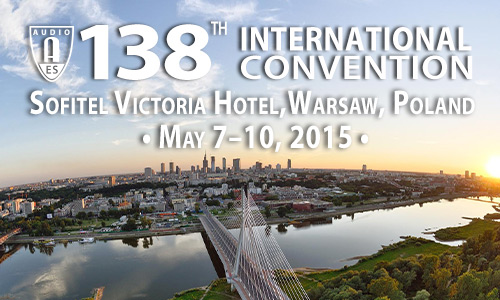
AES Warsaw 2015
Paper Session P6
P6 - (Lecture) Room Acoustics
Friday, May 8, 09:00 — 11:30 (Room: Królewski)
Chair:
Lauri Savioja, Aalto University - Aalto, Finland
P6-1 Radio Studio Acoustics Part 1: Subjective Evaluation—Ian Dash, Australian Broadcasting Corporation - Sydney, NSW, Australia; Mark Bowry, Australian Broadcasting Corporation - Sydney, NSW, Australia
A subjective evaluation exercise to determine the perceived acoustical quality of 12 small acoustic spaces used for radio production and presentation was conducted using two recording methods. One set of recordings used multiple microphones and the other set used a single microphone. A common listening test was run using both sets of recordings. The novel approach using multiple microphones was found to be a more sensitive and reliable method, and leads to different conclusions on acoustic performance criteria compared with a more conventional assessment. Group differences due to the reader, listener gender, listener location, and listener skill level were performed using ANOVA.
Convention Paper 9256 (Purchase now)
P6-2 Radio Studio Acoustics Part 2: Correlation of Objective Measurements with Subjective Assessment—Ian Dash, Australian Broadcasting Corporation - Sydney, NSW, Australia; Mark Bowry, Australian Broadcasting Corporation - Sydney, NSW, Australia
A subjective evaluation was made of the acoustic quality of 12 small- to medium-sized acoustic spaces used for radio production and presentation. Correlation analysis was used to relate the results from that evaluation to measured objective acoustical parameters of those rooms. The results suggest that low early reverberation time at lower frequencies is of high importance to listeners, and that listeners prefer consistent reverberation time in all bands from 125 Hz upwards.
Convention Paper 9257 (Purchase now)
P6-3 Estimation of Room Reflection Parameters for a Reverberant Spatial Audio Object—Luca Remaggi, University of Surrey - Guildford, Surrey, UK; Philip Jackson, University of Surrey - Guildford, Surrey, UK; Philip Coleman, University of Surrey - Guildford, Surrey, UK
Estimating and parameterizing the early and late reflections of an enclosed space is an interesting topic in acoustics. With a suitable set of parameters, the current concept of a spatial audio object (SAO), which is typically limited to either direct (dry) sound or diffuse field components, could be extended to afford an editable spatial description of the room acoustics. In this paper we present an analysis/synthesis method for parameterizing a set of measured room impulse responses (RIRs). RIRs were recorded in a medium-sized auditorium, using a uniform circular array of microphones representing the perspective of a listener in the front row. During the analysis process, these RIRs were decomposed, in time, into three parts: the direct sound, the early reflections, and the late reflections. From the direct sound and early reflections, parameters were extracted for the length, amplitude, and direction of arrival (DOA) of the propagation paths by exploiting the dynamic programming projected phase-slope algorithm (DYPSA) and classical delay-and-sum beamformer (DSB). Their spectral envelope was calculated using linear predictive coding (LPC). Late reflections were modeled by frequency-dependent decays excited by band-limited Gaussian noise. The combination of these parameters for a given source position and the direct source signal represents the reverberant or “wet” spatial audio object. RIRs synthesized for a specified rendering and reproduction arrangement were convolved with dry sources to form reverberant components of the sound scene. The resulting signals demonstrated potential for these techniques, e.g., in SAO reproduction over a 22.2 surround sound system.
Convention Paper 9258 (Purchase now)
P6-4 Sound Radiation Control for Reducing the Effect of Strong Reflections—Jiho Chang, Samsung Electronics Co. Ltd. - Suwon, Gyeonggi-do, Korea; Jaeyoun Cho, Samsung Electronics Co. Ltd. - Suwon-si, Gyeonggi-do, Korea; Yoonjae Lee, Samsung Electronics Co. Ltd. - Suwon, Gyeonggi-do, Korea
This paper is concerned with sound radiation control of a loudspeaker that has omni-directional radiation in free field condition. When the loudspeaker is placed very close to flat surfaces, the reflections from the surfaces are as strong as the direct sounds and deteriorate the omni-directionality. This study assumes a proximate wall and attempts to analyze the effect of a reflection from the wall in terms of the directivity and to improve the omni-directionality by using a circular array of loudspeakers. For a given distance, weights for loudspeakers are calculated that make the sound radiation omni-directional in spite of the wall.
Convention Paper 9259 (Purchase now)
P6-5 Acoustical Measurements of Warsaw’s Chamber Opera House Using Two Types of Sound Sources for Subsequent Auralization—Wieslaw Woszczyk, McGill University - Montreal, QC, Canada; Tadeusz Fidecki, F. Chopin University of Music - Warszawa, Poland; Jung Wook (Jonathan) Hong, McGill University - Montreal, QC, Canada; GKL Audio Inc. - Montreal, QC, Canada; Tomasz Rudzki, Frederic Chopin University of Music - Warszawa, Poland; Coherent Audio Systems; David Benson, McGill University - Montreal, Quebec, Canada; The Centre for Interdisciplinary Research in Music Media and Technology - Montreal, Quebec, Canada
Impulse response measurements using log sine sweeps were made in the Warsaw’s Chamber Opera House in eight microphone locations on the floor area and at two locations on the balcony, with two microphone elevations, using two types of sound sources having different directional radiation characteristics. The Opera House having only 159 seats originates from 1775 and is renowned for its excellent acoustics fitting for Mozart operas. The measurements show
how within this relatively small venue, an opera director can create a wide range of acoustic perspectives for voices and instruments, and achieve a desired dramatic effect. In a subsequent multichannel auralization, anechoic instrumental and vocal sounds were placed virtually in the opera house, and a listening panel compared the
renderings. The experiment underlines the importance of choosing directional characteristics of sound sources used in the measurements of room impulse responses intended for subsequent applications
Convention Paper 9260 (Purchase now)
